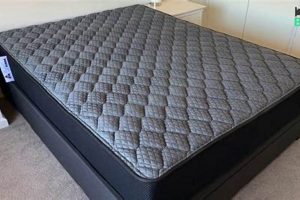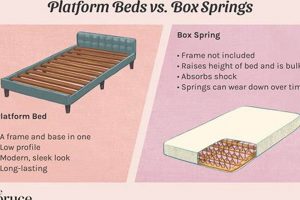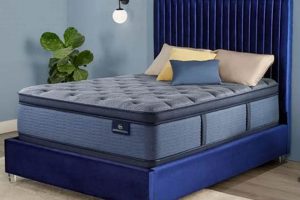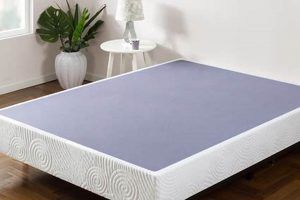The category describes mattresses that have been previously unboxed and, for various reasons, returned to the retailer or manufacturer. These items are typically inspected and often re-certified before being offered for sale at a reduced price. A prospective purchaser should consider the potential cost savings alongside factors such as hygiene and warranty coverage when considering such a purchase.
Acquiring items from this category presents an opportunity for significant cost reduction compared to purchasing a brand-new unit. This appeals to budget-conscious consumers. Furthermore, the pre-owned nature of these goods can contribute to sustainability efforts by reducing waste. Historically, the availability of these items has increased with the growth of online mattress retailers and their generous return policies.
Several factors influence the decision to purchase within this category. These considerations include the condition of the merchandise, the specifics of the seller’s return policy, and the availability of manufacturer warranties. Understanding these aspects is crucial for a successful and satisfactory purchase experience.
Guidance for Purchasing Previously Opened Mattresses
The acquisition of previously unboxed mattresses can represent a cost-effective alternative to purchasing new products. However, due diligence is paramount to ensure a satisfactory purchase.
Tip 1: Inspect the Mattress Thoroughly: A comprehensive physical inspection is essential. Examine the item for any visible stains, tears, or indentations. Particular attention should be paid to areas prone to wear, such as edges and seams.
Tip 2: Inquire About the Reason for Return: Understanding why the item was initially returned can provide valuable insight into its condition. Common reasons include size discrepancies, firmness preferences, or minor cosmetic imperfections.
Tip 3: Verify the Retailer’s Return Policy: Scrutinize the seller’s return policy regarding previously owned merchandise. Confirm whether returns are permitted and under what conditions, including any associated restocking fees.
Tip 4: Assess the Warranty Coverage: Determine if the manufacturer’s warranty remains valid on the specific item. Inquire whether the seller offers any supplemental warranty or guarantee to cover potential defects.
Tip 5: Request Detailed Product Information: Obtain complete details regarding the mattress’s age, usage history (if available), and any sanitization procedures performed by the seller prior to resale. This information assists in evaluating the item’s overall condition.
Tip 6: Compare Prices Strategically: While lower prices are expected, ensure that the savings adequately reflect the item’s condition and any limitations on warranty coverage or return options. Comparing prices across multiple vendors provides a benchmark.
Tip 7: Review Customer Feedback: Analyze customer reviews and ratings pertaining to the seller’s handling of previously owned merchandise. Focus on feedback regarding product quality, accuracy of descriptions, and customer service responsiveness.
Careful consideration of these factors mitigates potential risks associated with purchasing previously opened mattresses. Informed decision-making is key to securing a valuable and functional product.
This guidance facilitates a more confident approach to acquiring previously unboxed mattresses. Subsequent sections will explore specific brands and models within this product category.
1. Price Reduction
The primary incentive for considering previously unboxed mattresses stems directly from the potential for a marked price reduction compared to the cost of a new, sealed product. This reduction reflects the inherent depreciation associated with an item no longer considered “new,” despite often being in near-perfect condition. The cause of this reduction is the shift in market perception; a consumer is generally less willing to pay full price for a product that has potentially been used, even if briefly. For example, a high-end memory foam mattress retailing for $1500 new might be offered as a previously opened item for $900, representing a substantial saving of $600. This pricing strategy allows retailers to recoup some of their losses from returned merchandise while simultaneously attracting budget-conscious customers.
The importance of the price reduction as a component of a previously opened mattress cannot be overstated. Without a significant discount, the perceived risks associated with purchasing a non-new item, such as potential hygiene concerns or unknown use history, would likely outweigh the benefits for most consumers. Retailers leverage this discount to overcome consumer hesitancy and create a viable market for returned items. The level of the discount often directly correlates with the condition of the mattress; items with minor cosmetic flaws may be offered at deeper reductions than those that appear virtually untouched. Price transparency is vital, and responsible retailers clearly communicate the reason for the discount and the condition of the item to build consumer trust.
In conclusion, the price reduction is integral to the appeal and market viability of previously unboxed mattresses. This reduction compensates for the diminished perception of “newness” and inherent uncertainties. Understanding this dynamic is crucial for both consumers seeking value and retailers aiming to manage returned inventory effectively. However, shoppers must carefully balance the savings against potential risks by thoroughly inspecting the mattress and understanding the retailer’s policies regarding returns and warranties. This balance ensures an informed decision that aligns with individual needs and risk tolerance.
2. Condition Assessment
The assessment of a pre-owned mattress is paramount in determining its value and suitability for purchase. This process involves a detailed examination of various factors to ascertain the item’s overall state and potential longevity. Accurate assessment mitigates risks associated with acquiring previously owned goods.
- Visual Inspection for Stains and Damage
This involves a thorough examination of the mattress surface and sides for any visible marks, discoloration, or physical damage, such as tears or punctures. The presence of stains can indicate potential hygiene issues or liquid damage to the internal materials, affecting comfort and support. An example includes inspecting the mattress for signs of bed bugs, which can necessitate costly professional treatment. The implications include potential health risks and a reduction in the mattress’s lifespan.
- Evaluation of Structural Integrity
Structural assessment focuses on the mattress’s internal support system, including springs, foam layers, and edge support. This involves feeling for any areas of sagging, unevenness, or deformation. For instance, pocketed coil mattresses may experience individual coil failure, leading to localized sinkage and discomfort. Diminished structural integrity can compromise spinal alignment and lead to long-term discomfort. It may require costly repairs or result in a shortened lifespan, diminishing the overall value of the purchase.
- Odor Detection and Assessment
This aspect involves evaluating the mattress for any unpleasant or lingering odors. Such odors can stem from previous usage, spills, or inadequate storage conditions. Persisting odors, even after professional cleaning, can indicate mold growth or deeply embedded contaminants, affecting the air quality within the sleeping environment. An example would be the presence of a musty odor, potentially indicating mold, that could trigger allergic reactions or respiratory problems.
- Hygiene Verification
Hygiene assessment involves verifying the sanitization practices employed by the seller. Reputable sellers should provide documentation or detailed descriptions of their cleaning and disinfection procedures. Lack of proper sanitization can present health risks due to the potential presence of allergens, bacteria, or other contaminants. One must determine if industry-standard practices were used to eliminate any prior risks and ensure safety for the next user. This could include professional steam cleaning or antimicrobial treatments. Absence of such verification raises concerns regarding the mattress’s suitability for individuals with allergies or sensitivities.
These facets of condition assessment are interconnected and crucial for making informed decisions when considering previously unboxed mattresses. Each element contributes to the overall evaluation, directly affecting comfort, hygiene, and durability. Neglecting any of these areas increases the risk of acquiring a substandard product, diminishing the intended cost savings and potentially leading to health or discomfort issues.
3. Warranty Validity
The relationship between warranty validity and previously unboxed mattresses is a critical consideration for prospective purchasers. The standard manufacturer’s warranty, typically offered with new mattresses, may or may not extend to previously opened items. The primary determinant of warranty validity is often the retailer’s status as an authorized dealer and the circumstances under which the mattress was initially returned. If the mattress was returned due to a manufacturing defect covered by the original warranty, the warranty might remain applicable, provided the retailer reselling the item is authorized by the manufacturer.
However, warranties are frequently voided if the mattress was returned for reasons unrelated to manufacturing defects, such as comfort preference or incorrect size. Moreover, some manufacturers explicitly exclude previously unboxed items from warranty coverage, irrespective of the reason for return. Retailers may offer their own limited warranties on these items, but the scope and duration of such warranties are typically less comprehensive than the original manufacturer’s coverage. For example, a major online mattress retailer might provide a 30-day guarantee against defects on its pre-owned items, while the original manufacturer offered a 10-year warranty on new mattresses. This discrepancy highlights the importance of carefully reviewing the specific warranty terms associated with the item.
Therefore, due diligence is paramount. Potential buyers should directly inquire with the retailer and, if possible, the manufacturer to ascertain the precise warranty status of the previously unboxed mattress. Documentation of warranty coverage should be obtained in writing to avoid future disputes. Understanding the limitations of any warranty, or the absence thereof, is essential in evaluating the overall value proposition of a pre-owned mattress and mitigating potential financial risks associated with defects or premature wear. Consumers must weigh the cost savings against the potential lack of warranty protection when making a purchase decision.
4. Return Policies
Return policies are intrinsically linked to the concept of open box mattresses, acting as a cornerstone of consumer confidence within this market segment. The existence of a clear and equitable return policy directly influences a potential buyer’s willingness to consider a previously unboxed item. The primary cause of this connection is consumer apprehension regarding the condition and hygiene of mattresses lacking the original factory seal. A robust return policy mitigates this apprehension by providing a safety net, allowing purchasers to evaluate the product in their own homes and return it if it fails to meet expectations. For example, a retailer offering a 30-day, no-questions-asked return policy on its open box mattresses is likely to attract more customers than one with a strict “all sales final” policy. This difference stems from the reduced risk perceived by the consumer.
The importance of return policies as a component of open box mattresses extends beyond simply attracting initial sales. These policies also impact customer satisfaction and brand reputation. A positive return experience fosters trust and encourages repeat business. Conversely, restrictive or unclear return policies can lead to negative reviews and damage a retailer’s credibility. Some online mattress retailers, known for their generous return policies on new mattresses, extend comparable terms to their open box offerings, further enhancing consumer confidence. In practical terms, understanding the nuances of a retailer’s return policy is crucial. Factors such as the return window, shipping costs, restocking fees, and acceptable condition for returns should be carefully scrutinized before making a purchase.
In conclusion, return policies are a vital element in the open box mattress market. They address inherent consumer concerns about product quality and hygiene, influencing purchase decisions and shaping overall customer satisfaction. The presence of a fair and transparent return policy is not merely a customer service perk but a fundamental requirement for building trust and fostering a sustainable market for previously unboxed mattresses. Challenges remain in standardizing return policies across different retailers, highlighting the need for consumers to exercise due diligence and carefully evaluate the specific terms and conditions offered. This understanding is essential for navigating the open box mattress market effectively and minimizing potential risks.
5. Sanitization Process
The procedures employed to sanitize a previously unboxed mattress represent a crucial determinant of its suitability for resale and subsequent use. These protocols aim to mitigate potential health risks associated with prior usage and ensure that the item meets acceptable hygiene standards. The stringency and efficacy of the sanitization process directly impact consumer confidence and the perceived value of such mattresses.
- Initial Inspection and Contaminant Removal
The first stage involves a detailed visual inspection to identify any visible stains, debris, or signs of infestation. Physical contaminants, such as hair, dust mites, or bed bugs, are removed via vacuuming with HEPA-filtered equipment. Stains are addressed with specialized cleaning agents designed for mattress materials. Failure to adequately remove initial contaminants can compromise subsequent sanitization steps. For instance, residual organic matter can inhibit the effectiveness of antimicrobial treatments.
- Application of Disinfectants and Antimicrobial Agents
Following initial cleaning, disinfectants and antimicrobial agents are applied to the mattress surface and interior. These substances target bacteria, viruses, and fungi that may be present. Common disinfectants include quaternary ammonium compounds and hydrogen peroxide-based solutions. The selection of appropriate agents depends on the mattress material and the potential contaminants. Inadequate application or selection of inappropriate agents can result in incomplete disinfection, leaving residual microorganisms that pose a potential health risk.
- Steam Cleaning and Heat Treatment
Steam cleaning and heat treatment methods are employed to further sanitize the mattress and eliminate deeply embedded contaminants. High-temperature steam penetrates the mattress fibers, killing bacteria, viruses, and dust mites. Heat treatment involves subjecting the mattress to elevated temperatures within a controlled environment. These methods are particularly effective in eliminating allergens and pathogens that may survive chemical disinfection. However, improper execution of steam cleaning or heat treatment can damage the mattress materials, compromising its comfort and structural integrity.
- Ozone Treatment and Ventilation
Ozone treatment involves exposing the mattress to ozone gas, a powerful oxidizing agent that effectively eliminates odors and microorganisms. Ozone treatment is followed by thorough ventilation to remove residual ozone gas, which can be harmful if inhaled. This process is typically used as a final sanitization step to ensure the mattress is free from odors and contaminants. However, ozone treatment should be performed with caution, as prolonged exposure to high concentrations of ozone can damage certain mattress materials. Improper ventilation can result in residual ozone posing a health hazard to subsequent users.
These diverse sanitization methods, when implemented correctly, significantly reduce the risks associated with acquiring a previously unboxed mattress. Transparency regarding the specific sanitization protocols employed by the seller is essential for building consumer trust. Ultimately, the effectiveness of these procedures determines the safety and hygiene of the mattress, influencing its overall value and desirability in the secondary market.
6. Seller Reputation
The perceived integrity and reliability of the seller are critical components influencing the purchase decision of a pre-owned mattress. Given the inherent uncertainties surrounding an item lacking its original factory seal, the vendor’s reputation assumes heightened importance. A seller with a demonstrably positive track record instills consumer confidence, mitigating anxieties regarding hygiene, accurate product representation, and responsive customer service. For example, a mattress retailer known for transparent product descriptions, rigorous inspection processes, and accommodating return policies is more likely to attract customers to its selection of unboxed mattresses compared to a less reputable vendor with vague policies and limited customer support. This difference stems from the reduced perceived risk associated with the purchase.
The significance of seller reputation extends beyond the initial purchase. It impacts the likelihood of a satisfactory resolution in the event of defects or discrepancies. A reputable seller is generally more willing to honor warranties, facilitate returns, and address customer concerns promptly and professionally. Conversely, dealing with an untrustworthy vendor can lead to frustrating disputes and financial losses. In practical terms, assessing seller reputation involves examining customer reviews, ratings, and industry accreditations. Online marketplaces often feature seller ratings and feedback, providing valuable insights into past customer experiences. It is also prudent to verify the seller’s physical address and contact information to ensure legitimacy. Scrutinizing the seller’s website for clear and comprehensive information about their business practices further contributes to an informed assessment.
In conclusion, seller reputation is an indispensable consideration when navigating the market for previously unboxed mattresses. It serves as a crucial safeguard against potential risks associated with this product category. By carefully evaluating the vendor’s track record, consumers can enhance their likelihood of a positive purchase experience and mitigate the potential for dissatisfaction or financial loss. This understanding necessitates thorough due diligence and a critical evaluation of available information before committing to a purchase.
Frequently Asked Questions Regarding Previously Unboxed Mattresses
The following addresses common inquiries pertaining to mattresses that have been previously opened but not used extensively. This information aims to clarify the nuances associated with these items.
Question 1: What exactly constitutes a “previously unboxed” mattress?
The term refers to a mattress that has been removed from its original packaging but remains in a condition suitable for resale. These mattresses are often returned to retailers due to factors such as incorrect size, firmness preferences, or minor cosmetic imperfections discovered upon initial unboxing. It is important to note that “previously unboxed” does not necessarily imply prior usage for sleeping purposes, but rather a brief period of exposure outside of its original packaging.
Question 2: Are previously unboxed mattresses hygienic?
The hygiene of such mattresses is contingent upon the sanitization procedures employed by the seller. Reputable retailers implement rigorous cleaning and disinfection protocols to eliminate potential contaminants. These processes may involve steam cleaning, antimicrobial treatments, and ozone sanitation. Consumers should inquire about the specific methods used by the seller and request documentation to verify the effectiveness of these procedures. The presence of certifications from independent testing organizations provides additional assurance of hygiene.
Question 3: Does the manufacturer’s warranty apply to a previously unboxed mattress?
The applicability of the original manufacturer’s warranty varies depending on the specific terms and conditions outlined by the manufacturer and the reason for the mattress’s initial return. In some cases, the warranty remains valid if the mattress was returned due to a manufacturing defect. However, the warranty is typically voided if the return was due to reasons unrelated to defects, such as comfort preference. Consumers should directly contact the manufacturer or retailer to ascertain the warranty status of a specific mattress.
Question 4: What level of price reduction should one expect on a previously unboxed mattress?
The price reduction on such mattresses is dependent upon several factors, including the mattress’s condition, age, original retail price, and the seller’s pricing strategy. Generally, consumers can anticipate savings ranging from 20% to 50% compared to the price of a new, sealed mattress. Mattresses with minor cosmetic flaws may be offered at deeper discounts than those in pristine condition. Price comparison across multiple vendors is recommended to ensure a competitive price.
Question 5: What are the potential risks associated with purchasing a previously unboxed mattress?
The primary risks include the possibility of undisclosed damage, diminished hygiene, and limited warranty coverage. While reputable sellers implement sanitization processes and provide detailed product descriptions, there remains a potential for oversight. Thorough inspection of the mattress upon delivery is essential to identify any discrepancies or defects not disclosed by the seller. Understanding the limitations of any warranty or return policy is crucial in mitigating financial risks associated with potential issues.
Question 6: What recourse is available if a previously unboxed mattress is found to be defective?
Recourse depends on the seller’s return policy and any applicable warranty coverage. If the mattress is found to be defective within the specified return period, consumers can typically request a refund or exchange. If a valid warranty is in effect, the manufacturer or retailer may offer repair or replacement options. In cases where the seller is unresponsive or uncooperative, consumers may pursue legal remedies or file complaints with consumer protection agencies.
In summation, acquiring a previously unboxed mattress entails a blend of potential cost savings and inherent risks. Diligent research, thorough inspection, and a clear understanding of the seller’s policies are crucial for navigating this market segment effectively.
The subsequent section delves into strategies for negotiating the purchase of a previously unboxed mattress to secure the most favorable terms.
Open Box Mattress
This exploration has elucidated the nuances associated with purchasing mattresses within the “open box mattress” category. Key considerations include thorough condition assessment, verification of warranty validity, scrutiny of return policies, evaluation of sanitization processes, and assessment of seller reputation. Careful attention to these elements is essential to mitigate inherent risks and maximize potential cost savings.
The decision to acquire a mattress from this segment necessitates a balanced approach, weighing the allure of reduced prices against the potential for diminished warranty coverage and the importance of ensuring adequate hygiene. Responsible consumers must exercise due diligence and critically evaluate all available information before committing to a purchase. The future viability of this market hinges on retailers maintaining transparency and implementing robust quality control measures.







![Best Box Spring & Mattress Queen Set [Deals!] Organic & Natural Mattress Buyer’s Guide: Non-Toxic Sleep Solutions Best Box Spring & Mattress Queen Set [Deals!] | Organic & Natural Mattress Buyer’s Guide: Non-Toxic Sleep Solutions](https://mattressworldpa.com/wp-content/uploads/2025/07/th-3396-300x200.jpg)